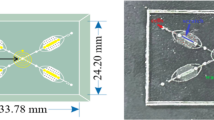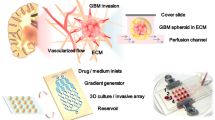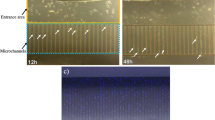Abstract
Objective
To investigate the anti-invasion efficacy of the ethanol extract of Oldenlandia diffusa Will. (EEOD) on a three-dimensional (3D) human malignant glioma (MG) cell invasion and perfusion model based on microfluidic chip culture and the possible mechanism of action of Oldenlandia diffusa Will. (OD).
Methods
The comprehensive pharmacodynamic analysis method in this study was based on microfluidic chip 3D cell perfusion culture technology, and the action mechanism of Chinese medicine (CM) on human MG cells was investigated through network pharmacology analysis. First, the components of EEOD were analyzed by ultraperformance liquid chromatography with quadrupole time-of-flight mass spectrometry (UPLC-Q-TOF/MS). Then, cell viability and apoptosis were assessed to determine the optimum concentration of EEOD for invasion experiments, and two-dimensional (2D) migration and invasion abilities of U87 and U251 MG cells were evaluated using scratch wound and Transwell assays. The possible mechanism underlying the effects of EEOD on glioma was analyzed through a network pharmacology approach.
Results
Thirty-five compounds of EEOD were detected by UPLC-Q-TOF/MS. EEOD suppressed the viability of MG cells, promoted their apoptosis, and inhibited their migratory and invasive potentials (all P<0.05). Network pharmacology analysis showed that OD inhibited the invasion of MG cells by directly regulating MAPK and Wnt pathways through MAPK, EGFR, MYC, GSK3B, and other targets. The anti-invasion effect of OD was also found to be related to the indirect regulation of microtubule cytoskeleton organization.
Conclusions
]EEOD could inhibit the invasion of human MG cells, and the anti-invasion mechanism of OD might be regulating MAPK and Wnt signaling pathways and microtubule cytoskeleton organization.
Similar content being viewed by others
References
Ostrom QT, Bauchet L, Davis FG, Deltour I, Fisher JL, Langer CE, et al. The epidemiology of glioma in adults: a state of the science review. Neuro Oncol 2014;16:896–913.
Stoellinger HM, Alexanian AR. Modifications to the transwell migration/invasion assay method that eases assay performance and improves the accuracy. Assay Drug Dey Techn 2022;20:75–82.
Ishiguro T, Ohata H, Sato A, Yamawaki K, Enomoto T, Okamoto K. Tumor-derived spheroids: relevance to cancer stem cells and clinical applications. Cancer Sci 2017;108:283–289.
Bai J, Gao C, He L, Jia M, Zhang QH. Progress in clinical diagnosis and treatment of high grade glioma. Med Recapitul 2017;23:2978–2982.
Liu NN, Li RH. Related research progress of traditional chinese medicine in the treatment of glioma. J Liaoning Univ Tradit Chin Med (Chin) 2017;19:220–224.
Yang LN, Wu ZL, Yang ZJ, Li SG, Ouyang CS. Exploring mechanism of key Chinese herbal medicine on breast cancer by data mining and network pharmacology methods. Chin J Integr Med 2021;27:919–926.
Wajima T, Anzai Y, Yamada T, Ikoshi H, Noguchi N. Oldenlandia diffusa extract inhibits biofilm formation by haemophilus influenzae clinical isolates. PLoS One 2016;11:e0167335.
Chung TW, Choi H, Lee JM, Ha SH, Kwak CH, Abekura F, et al. Oldenlandia diffusa suppresses metastatic potential through inhibiting matrix metalloproteinase-9 and intercellular adhesion molecule-1 expression via p38 and ERK1/2 MAPK pathways and induces apoptosis in human breast cancer MCF-7 cells. J Ethnopharmacol 2017;195:309–317.
Chen R, He J, Tong X, Tang L, Liu M. The Hedyotis diffusa Willd. (Rubiaceae): a review on phytochemistry, pharmacology, quality control and pharmacokinetics. Molecules 2016;21:710.
Feng XJ, Du W, Luo QM, Liu BF. Microfluidic chip: next-generation plat-form for systems biology. Anal Chim Acta 2009;650:83.
Rambøl MH, Han E, Niklason LE. Microvessel network formation and interactions with pancreatic islets in three-dimensional chip cultures. Tissue Engin 2020;26:9–10.
Li S, Lin Z, Jiang H, Tong L, Wang H, Chen S. Rapid identification and assignation of the active ingredients in Fufang Banbianlian Injection using HPLC-DAD-ESI-IT-TOF-MS. J Chromatogr Sci 2016;54:1225–1237.
Sun L, Peng QS, Qu LL, Gong LL, Si J. Anticancer agent icaritin induces apoptosis through caspase-dependent pathways in human hepatocellular carcinoma cells. Mol Med Rep 2015;11:3094–3100.
Wang YS, Lin RT, Cheng HY, Yang SF, Chou WW, Hank Juo SH. Anti-atherogenic effect of San-Huang-Xie-Xin-Tang, a traditional Chinese medicine, in cultured human aortic smooth muscle cells. J Ethnopharmacol 2011;133:442–447.
Zhang X, Zhang Y, Li YH. β-elemene decreases cell invasion by upregulating E-cadherin expression in MCF-7 human breast cancer cells. Oncol Rep 2013;30:745–750.
Wang YC, Ma JY, Li N, Wang L, Shen LM, Sun Y. Microfluidic engineering of neural stem cell niches for fate determination. Biomicrofluidics 2017;11:014106.
Yue SJ, Xin LT, Fan YC, Li SJ, Tang YP, Duan JA. Herb pair Danggui-Honghua: mechanisms underlying blood stasis syndrome by system pharmacology approach. Sci Rep 2017;7:40318.
Li J, Zhao P, Li Y, Tian Y, Wang Y. Systems pharmacology-based dissection of mechanisms of Chinese medicinal formula Bufei Yishen as an effective treatment for chronic obstructive pulmonary disease. Sci Rep 2015;5:15290.
Yeh WL, Lin HY, Huang CY, Huang BR, Lin C, Lu DY, et al. Migration-prone glioma cells show curcumin resistance associated with enhanced expression of miR-21 and invasion/anti-apoptosis-related proteins. Oncotarget 2015;35: 37770–37781.
Qu C, Ma JY, Zhang YJ, Han C, Huang L, Shen LM, et al. Estrogen receptor variant ER-α36 promotes tamoxifen agonist activity in glioblastoma cells. Cancer Sci 2019;110:221–234.
Satelli A, Li SL. Vimentin in cancer and its potential as a molecular target for cancer therapy. Cell Mol Life Sci 2011;68:3033–46.
Feng JH, Song DL, Jiang SY, Yang XH, Ding TT, Zhang H, et al. Quercetin restrains TGF-β1-induced epithelial-mesenchymal transition by inhibiting Twist1 and regulating E-cadherin expression. Biochem Biophys Res Commun 2018;498:132–138.
Liu Z, Liu M, Liu M, Li J. Methylanthraquinone from Hedyotis diffusa Willd induces Ca(2+)-mediated apoptosis in human breast cancer cells. Toxicol In Vitro 2010;24:142–147.
Elsayed HE, Ebrahim HY, Mohyeldin MM, Siddique AB, Kamal AM, Haggag EG, et al. Rutin as a novel c-Met inhibitory lead for the control of triple negative breast malignancies. Nutr Cancer 2017;69:1256–1271.
Yang J, Xiao P, Sun J, Guo L. Anticancer effects of kaempferol in A375 human malignant melanoma cells are mediated via induction of apoptosis, cell cycle arrest, inhibition of cell migration and downregulation of m-TOR/PI3K/AKT pathway. J Buon 2018;23:218–223.
Wu Q, Needs PW, Lu Y, Kroon PA, Ren D, Yang X. Different antitumor effects of quercetin, quercetin-3′-sulfate and quercetin-3-glucuronide in human breast cancer MCF-7 cells. Food Funct 2018;9:1736–1746.
Sghaier MB, Pagano A, Mousslim M, Ammari Y, Kovacic H, Luis J. Rutin inhibits proliferation, attenuates superoxide production and decreases adhesion and migration of human cancerous cells. Biomed Pharmacothe 2016;84:1972–1978.
Habtemariam S, Lentini G. The therapeutic potential of rutin for diabetes: an update. Mini Rev Med Chem 2015;15:524–528.
Luo J, Hu YL, Wang H. Ursolic acid inhibits breast cancer growth by inhibiting proliferation, inducing autophagy and apoptosis, and suppressing inflammatory responses via the PI3K/AKT and NF-βB signaling pathways in vitro. Exp Ther Med 2017;14:3623–3631.
Yoo YG, Oh SH, Park ES, Cho H, Lee N, Park H, et al. Hepatitis B virus X protein enhances transcriptional activity of hypoxia-inducible factor-1alpha through activation of mitogen-activated protein kinase pathway. J Biol Chem 2003;278:39076–39084.
Du Y, Wang Y, Zhang F, Wu W, Wang W, Li H, et al. Regulation of metastasis of bladder cancer cells through the Wnt signaling pathway. Tumour Biol 2015;36:8839–8844.
Zhan T, Rindtorff N, Boutros M. Wnt signaling in cancer. Oncogene 2017;36:1461–1473.
Hall A. The cytoskeleton and cancer. Cancer Metastasis 2009;28:5–14.
Author information
Authors and Affiliations
Contributions
Han CH conducted the design and the main experiments of this study and drafted the manuscript. Ma JY designed the microfluidic chip and directed this part of the experiment. Zou W supervised the writing of the thesis. Qu JL directed and participated in the UPLC-Q-TOF/MS experiment. Du Y participated in the exploration of UPLC experimental conditions. Li N participated in the experiment of 3D cells perfusion culture on microfluidic chips. Liu Y took part in the design of the CM experiment in this study. Jin G participated in the revision of the article. Leng AJ participated in the extraction and analysis of the herb and the promotion of the project. Liu J led the design of the study and promotion of the project. All authors read and approved the final manuscript.
Corresponding author
Ethics declarations
The authors declare no conflicts of interest.
Additional information
Supported by the National TCM Characteristic Technology Inheritance Talent Training Program (National TCM Education Letter [2019]43, No. J20194828003)
Supplementary material
11655_2021_3726_MOESM1_ESM.pdf
3D Microfluidic System for Evaluating the Inhibitory Effect of Chinese Herbal Medicine Oldenlandiadiffusaon Human Malignant Glioma Invasion Combined with Network Pharmacology Analysis
Rights and permissions
About this article
Cite this article
Han, Ch., Ma, Jy., Zou, W. et al. 3D Microfluidic System for Evaluating Inhibitory Effect of Chinese Herbal Medicine Oldenlandia diffusa on Human Malignant Glioma Invasion Combined with Network Pharmacology Analysis. Chin. J. Integr. Med. 29, 52–60 (2023). https://doi.org/10.1007/s11655-021-3726-1
Accepted:
Published:
Issue Date:
DOI: https://doi.org/10.1007/s11655-021-3726-1




